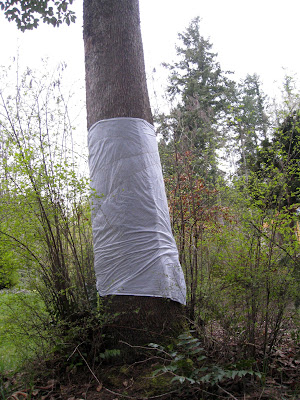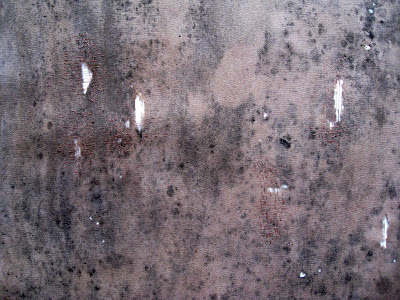A journal where I share my adventures developing a food forest based on permaculture principles. I also share my love of knitting here. For my life as a textile artist follow me at lesleyturnerart.com
Thursday, April 5, 2012
Wednesday, April 4, 2012
Checking the Tree Cloths
Tuesday, April 3, 2012
Wrapping Another Set of Trees
Monday, April 2, 2012
BA(Hons) Studies Continue in September
Saturday, March 31, 2012
Decisions Decisions

Throughout this term of my studies I had continued to move along about 8 other dialogues out in the forest that I had established during the previous term. By the end of the winter term I decided my final degree exhibition would be about the tree cloths - a big decisions when I still had so much to resolve. This meant I needed to wrap another set of cloths around the trees and I needed to do it now to give the trees as much time as possible to get busy staining the cloth.

I liked the idea of pre-mordanting the cloth in sea water just a short distance away from where the trees are growing. Sampling had shown sea water to be an effective pre-mordant on cotton. A pre- mordant was likely to stimulate the staining process.

I made another decision too. The cloths would be bed sheets my 3 children slept on while growing up.

I liked the idea of using the same nurturing cloths being used to express my need to get to know these trees.

An important part of my work is to use textiles with an accumulated history. During a research module I had written a paper looking at how different artists worked with the human imprint on cloth.
While I soaked the sheets in the sea, 2 men threw a ball for their dog and watched me. When I walked back towards them they said, 'We have to ask. Art or science?' I said, 'both.'
While I soaked the sheets in the sea, 2 men threw a ball for their dog and watched me. When I walked back towards them they said, 'We have to ask. Art or science?' I said, 'both.'
Friday, March 30, 2012
Repair and Mending Tree Cloths
Thursday, March 29, 2012
Adding My Staining to Tree Cloths

I am at the stage in my dialogue with the trees where it is my turn to respond. I need to make a mark reflecting the development of my relationship with these trees. I sampled dyeing with a Cedar branch extraction but wasn't enamoured with the colour nor the overall even covering of the tree's marks. Next I sampled more textural dyed marks using Procion MX colours.
Wednesday, March 28, 2012
Making My Mark on the Tree Cloths
After noticing Cedar stems left a print on cotton, I decided to make a dye with them. I collected windfall branches, cut them into small pieces....
...brought them to a boil, simmered for 2 hours then left the pot to cool overnight. I poured off the liquid as the 1st extraction and repeated the process twice more, making 2nd and 3rd extractions.
I dyed 2 sea-water, pre-mordanted cloths in the 1st extraction with a copper simultaneous-mordant. The cloth on the left had an ammonia post-mordant.
These 2 cloths had ash water pre-mordant with a copper simultaneous-mordant. The left hand cloth had an ammonia post-mordant. The results were a yellow-orange colour with the ammonia post-mordant shifting the colour more towards an orange. Interesting results but i wasn't enamoured with the colour. Even though the dye was made with material from the same tree that made the 1st stains, I couldn't see a connection between the two.
Subscribe to:
Posts (Atom)






































